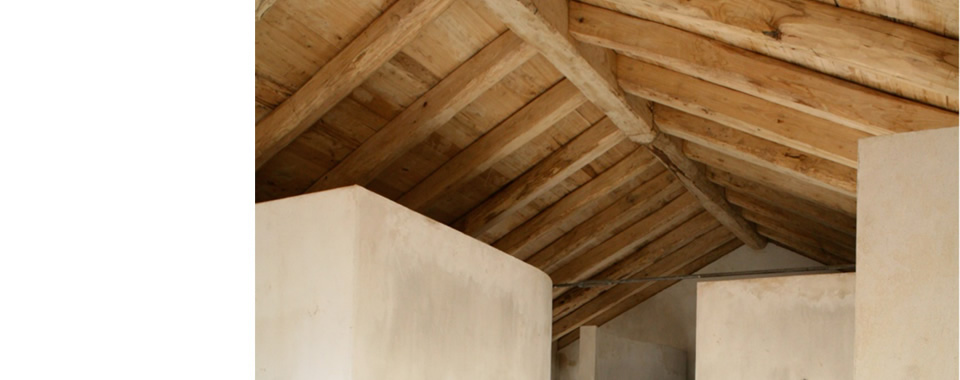

Score - Sustainable Construction in Rural and Fragile Areas for Energy efficiency
Guidelines for Integrated territorial Planning:
Geothermic
The following guidelines come from a deep analysis of case studies, norms and regulations, in relation to the local level. This analysis is summarized in a card that can be downloaded in spanish language. The geothermic technology systems are based in the possibilities of interchanging energy, offered in a natural way, by almost all kind of soils, as temperature remains constant at some meters under the surface. That way, the system can gain or dissipate heat, depending on the needs, through a primary buried pipes circuit crossed by a thermic fluid, usually water plus antifreeze liquid. We have to distinguish this kind of technology, known as low-temperature geothermic, from high temperature systems, which take advantage from the radioactive decay of minerals (geysers), releasing energy in zones closer to the earth core.
The most common geothermic systems used in the buildings are the low-temperature with horizontal or vertical interchangers as a part of a heat pump, which are able to use the solar energy collected by the first ground layers. The principles of geothermic resources can be adapted to air conditioning (heating or cooling) and hot water systems of several use buildings, reducing the electricity consumption needed in a regular non-renewable construction, and helping in the control of the environment impact of city development. This versatility (one only equipment is needed for heating/cooling production, despite the outside weather or the night-day cycle) is one of the strong points of this technology in front of others. The aesthetical features are also a remarkable characteristic, as the no presence of external equipment makes geothermic an ideal option in historic environments and in refit or refurbishment projects. In the other hand the thermal efficiency of the system is lower than solar collectors, for example, in summer; and due to the warm Mediterranean climate, with mild winters, the difference between air and ground temperature is not as high as in northern countries. Even so, the efficiency of geothermic heat pumps is much higher than simply electric supplied ones. It`s also necessary to make some preliminary ground studies to assure the first investment profitability, increasing the final cost of the installation.
So here we got some of the main reasons why geothermical technology is not enough extended in the andalusian region. First of all, other kind of systems related with solar energy, with a direct and well known response in the mediterranean climate, are preferred. Consequently, there is a lack of specialized technicians and companies with a definite experience, and is difficult to find education and research programs in geothermic energy production. In addition, the regulation and laws about these systems are not specific, and is necessary to adapt the existing for getting the corresponding licenses and permissions, especially in the case of vertical interchangers that need an authorization for miner prospecting.
The second main difficulty is related with economical aspects. As we saw before, the implementation of geothermic installations are preceded by an analysis of the soil in the affected plot. The cost of these studies is added to the system construction expenses, which are higher in the case of vertical models. This means a 50-150 % of costs increase in relation with conventional systems. Therefore, the amortization period for this technology is longer, especially for small projects, like single-family residential buildings. This gap in the first investment profitability was usually saved by subventions provided by regional administration. This policy is now in danger due to the current economical situation.
The diffusion of sustainable works of geothermic systems, could be facilitated following some advices such as:
- Diffusion, research and education programs about this technology in the aim of creating a consolidated net of professionals and companies specialized in this renewable energy;
- Enacting specific laws and regulations that can guide and ease the exploitation of geothermic resources.
- Promote the creation of manufacture companies that can make products related with this technology, avoiding the need of import them from northern countries.
- Maintain the policy of economic help for this technology, at least in the first phases of diffusion.
Indication for the Bio-construction Action Plan
Pursuant to the guidelines written above, here are synthetically reported the criteria/examples for pilot projects to be financed in MED territory, in relation with the specific treated theme.
These criteria/examples, together with the ones resulting from all the themes of eco-construction tool matrix, will make up a Bio-construction Action Plan for each partner countries.
- Projects for education and research programs about geothermic energy, which would help in the creation of qualified net of professionals and companies, able to offer a near and adequate service to final users.
- Projects for normative/regulations structure adjustment or enacting new specific laws, especially for regional level, aimed to ease the exploitation of geothermic resources.
Possible criteria for MED bio–housing quality certificate
The internationally recognized green building certifications, normally give few indications about the use of geothermic systems. The same happens for the most common spanish certification system. Nowadays the only current regulation about this theme is the Decree 47/2010 (Basic Procedure for Energetic Efficiency Certification in New Buildings), which make reference to the Rules for Building Thermal Systems (RITE) and the Technical Building Code (CTE). These rules are focused in solar alternative (solar collectors and photovoltaic) and the limitation of conventional energy using only for hot water or heating production (point 2.1 of HE-4, CTE; points IT.1.2.4.6 and IT.1.2.4.7, RITE). It isn’t considered necessary that green building certifications as should be made more complicated. However we think it would be recommended to consider limitations of the whole energy consumption of buildings, including cooling or electricity.
Case studies
- Project for Senior Citizens Residence, Jaén.
- MiKasa Suites and Spa Hotel, Agua Amarga (Almería)
- IKEA Commercial Center, Jerez de la Frontera (Cádiz) .
